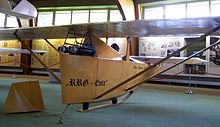Lippisch Ente
This articleneeds additional citations forverification.(August 2012) |
| Ente | |
|---|---|

| |
| RRG Raketen-Ente | |
| Role | Experimental glider |
| National origin | Germany |
| Manufacturer | Alexander LippischandOpel-RAK |
| Designer | Alexander Lippisch (glider); Fritz von Opel, Max Valier, Friedrich Sander (rocket propulsion) |
| First flight | 1928 |
| Number built | 1 |
TheEnte(German:duck) was the world's first full-sized rocket-powered aircraft. It was designed byAlexander Lippischas asailplaneand first flown under power on June 11, 1928, piloted byFritz Stameras part of theOpel-RAKrocket program led byFritz von OpelandMax Valier.[1]
During the late 1920s von Opel had made a variety of demonstrations involving rocket-powered vehicles for theOpelcompany. He was assisted by thepyrotechnicsmanufacturerFriedrich Sanderand the rocketry advocateMax Valier.In March 1928 the three men visited theWasserkuppe,a mountain which had become the center of Germanglidingto investigate the possibility of fitting rockets to an aircraft. There they encountered some of Lippisch's revolutionary gliders, which because of their tail-less designs seemed suitable for adapting to rocket propulsion. Lippisch was able to demonstrate how models of his aircraft would fly with small rockets installed in them. In June von Opel, Sander, and Valier returned and bought one of his aircraft, the Ente, acanarddesign.
Twoblack powderrockets were installed, to be electrically fired by a switch in the cockpit. A counterweight system was also devised and placed under the cockpit floor which would automatically adjust the aircraft'scenter of gravityas the fuel of the rockets was consumed. The rockets were intended to be fired one after the other, to provide continuous thrust for as long as possible, and each had a burn time of around 30 seconds. Fritz Stamer, who had long been atest pilotfor Lippisch's designs was selected to fly the aircraft. After one false start, the aircraft took off and flew a 1,500 metre (4,900 ft) circuit of the Wasserkuppe's landing strip.
On the second flight, the team decided to try firing both rockets together for increased thrust over a shorter period. However, rather than burning properly one of the rockets exploded, punching holes in both wings and setting the aircraft alight. Stamer was nevertheless able to bring it down from a height of around 20 metres (65 ft) before hastily abandoning the Ente, which was burned beyond any hope of repair.
TheOpel RAK.1was developed as the successor to the "Ente", and was demonstrated successfully to the public in September 1929 with Fritz von Opel as pilot.
Specifications (RRG Raketen-Ente)
[edit]
Data from[2]
General characteristics
- Crew:1
- Length:4.31 m (14 ft 2 in)
- Wingspan:11.94 m (39 ft 2 in)
- Wing area:20.3 m2(219 sq ft)
- Aspect ratio:7
- Powerplant:2 × Sander black powder rockets, 0.1962 kN (44.1 lbf) thrust each
Performance
- Range:1.5 km (0.93 mi, 0.81 nmi)
References
[edit]- ^Ford, Roger (2013).Germany's Secret Weapons of World War II.London, United Kingdom: Amber Books. p. 224.ISBN9781909160569.
- ^"RRG-Raketen Ente"(in German). Germany: www.segelflugmuseum.de. Archived fromthe originalon 30 January 2018.Retrieved17 August2012.
